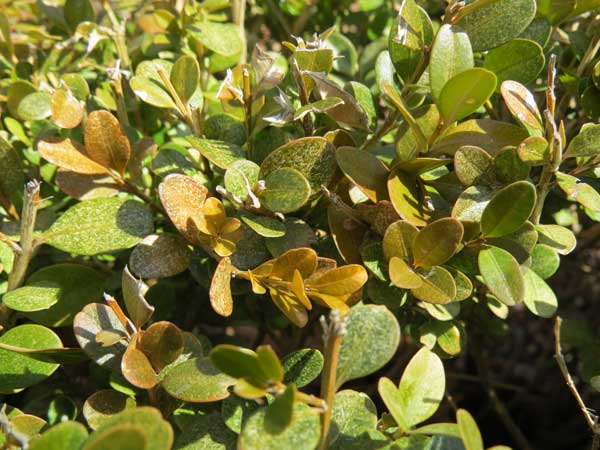Boxwoods are a popular evergreen shrub used in many landscapes. However, they can suffer damage from both winter burn and fungal blights. Telling the difference between these two issues is important as the treatments and long-term effects on the plants vary. This article will examine how to distinguish boxwood winter burn from blight based on symptoms causes, and patterns of damage.
What Causes Boxwood Winter Burn?
Boxwood winter burn, also called winter desiccation, refers to foliage damage caused by environmental factors during the cold winter months. It typically occurs when:
-
Cold, dry winter winds remove moisture from boxwood foliage faster than the roots can absorb water from frozen soil. This leads to drying out and browning of the leaves and shoots.
-
Exposure to severe cold and wide temperature fluctuations without protection causes freeze damage to foliage
-
Bright winter sunlight reflects off snow and ice, intensifying desiccation
-
Soil moisture reserves are low going into winter due to drought, inadequate watering, or poor drainage.
While winter burn itself doesn’t spread, it can weaken boxwoods and make them more prone to pests and disease. It mainly affects the outer portions of the plant.
What Causes Boxwood Blight?
Boxwood blight is caused by the fungal pathogen Calonectria pseudonaviculata (previously known as Cylindrocladium buxicola). Spores spread in humid conditions and infect the foliage, twigs, and stems. Blight causes:
-
Dark or light brown leaf spots with purple or black borders
-
Black streaking on stems
-
Defoliation of infected branches
-
Rapid leaf drop in humid weather
-
Dieback of twigs and branches
-
Plant death in severe cases
Blight spreads quickly via wind, splashing water, and infected tools or plants. The entire plant can be affected, including inner branches.
Comparing Symptoms of Winter Burn vs Blight
Here are some key differences in the symptoms of boxwood winter burn vs blight:
Winter Burn
-
Bronzing, browning, or yellowing of foliage
-
Tip and marginal leaf necrosis
-
Affected leaves remain attached
-
Worst on exposed side of plant
-
Distinct “snowline” between damaged and healthy foliage
-
Older foliage affected more than new growth
Blight
-
Light or dark brown leaf spots with black edges
-
Drooping, wilting, or defoliation
-
Black streaking on stems
-
Affected leaves often drop
-
Entire plant can be impacted
-
No pattern to damage; inner branches affected
-
New growth shows symptoms
Identifying Boxwood Winter Burn vs Blight
To distinguish between winter burn and blight:
-
Look for a clear demarcation of damage at the snow line for winter burn. This indicates that the exposed portions suffered from desiccation. Blight will show a more random pattern.
-
With blight, leaves often drop off entirely, while winter burn causes browned leaves to remain attached.
-
The spread of blight accelerates during humid, wet weather. Winter burn stabilizes once warmer spring weather arrives.
-
Monitor for continued progression of damage once warmer weather returns. Blight will continue to spread while winter burn damage should remain stable.
-
Send a sample to a diagnostic lab if you are uncertain. They can test for the blight pathogen.
Treating and Preventing Winter Burn vs Blight
For winter burn:
-
Prune out dead twigs in spring and shape plants after damage stabilizes.
-
Improve conditions like drainage and moisture retention with amended soil and mulch.
-
Prevent winter desiccation by protecting plants with wind barriers and anti-transpirants.
-
Maintain optimal soil moisture in fall and winter with consistent watering.
For blight:
-
Prune and destroy infected plant parts promptly. Sterilize tools between cuts.
-
Remove and destroy severely infected plants to prevent spread.
-
Use fungicides labeled for boxwood blight as a protective treatment.
-
Promote airflow and avoid overcrowding of plants.
-
Disinfect tools, yard waste, and shoes to prevent spread.
Catching boxwood damage early and accurately identifying whether it is caused by winter burn or blight is important for proper treatment. With vigilance and appropriate care, you can help your boxwoods recover from winter injury and avoid fungal infection.
Boxwood Winter Burn or Boxwood Blight
FAQ
How do you tell the difference between winter damage and boxwood blight?
How do I know if my boxwood is blight?
Can boxwoods recover from winter burn?
Can boxwood blight be cured?
- A Complete Guide to Caring for Yuki Cherry Blossom Shrub - January 23, 2025
- Identifying Red Hot Poker Seeds: What to Look For When Harvesting Torch Lily Pods - January 23, 2025
- A Complete Guide to Harvesting Evening Primrose Seeds - January 23, 2025

